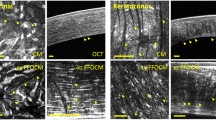Summary
The uveal tract of the eyes of monkeys was examined by electron microscopy using both thin sections and freeze-fracture replicas. The ultrastructural features of the lamina fusca in the monkey resembled those previously described for rabbit. The lamina fusca was composed of numerous interleaved processes of fibroblastic and pigmented cells and contained tight junctions between fibroblastic cell processes that were predominantly discontinuous, as well as numerous fenestrations through the attenuated cell processes. There was no regional compaction of cellular processes traversing the entire uvea at the level of the ora serrata as reported previously in hamster eyes.
Similar content being viewed by others
References
Acott TS, Wescott M, Passo MS, Von Buskirk EM (1985) Trabecular meshwork glycosaminoglycans in human and cynomolgus monkey eyes. Invest Ophthalmol Vis Sci 26:1320–1329
Bellhorn RW (1981) Permeability of blood-ocular barriers of neonatal and adult cats to fluorescein labeled dextrans of selected molecular sizes. Invest Ophthalmol Vis Sci 21:282–290
Bill A (1965) Aqueous humor drainage mechanism in the cynomolgus monkey (Macaca irus) with evidence for unconventional routes. Invest Ophthalmol 4:911–919
Bill A (1966) Conventional and uveo-scleral drainage of aqueous humour in the cynomolgus monkey (Macaca irus) at normal and high intraocular pressures. Exp Eye Res 5:45–54
Cole DF, Monro PAG (1976) The use of fluorescein-labeled dextrans in investigation of aqueous humor outflow in the rabbit. Exp Eye Res 23:571–585
Fine BS, Yanoff M (1979) Ocular histology, A text and atlas, 2nd edn. Harper and Row, New York, pp 215–216
Grayson MC, Laties AM (1971) Ocular localization of sodium fluorescein. Arch Ophthalmol 85:600–609
Hageman GS, Kelly DE (1984) Fibrillar and cytoskeletal substructure of tight junctions: Analysis of single-stranded tight junctions linking fibroblasts of the lamina fusca in hamster eyes. Cell Tissue Res 238:545–557
Inomata H, Bill A (1977) Exit sites of uveoscleral flow of aqueous humor in cynomolgus monkey eyes. Exp Eye Res 25:113–118
Inomata H, Bill A, Smelser GK (1972) Aqueous humor pathways through the trabecular meshwork and into Schlemm's canal in the cynomolgous monkey (Macaca irus), an electron microscopic study. Am J Ophthalmol 73:760–789
Kelly DE, Hageman GS, McGregor JA (1983) Uveal compartmentation in the hamster eye revealed by fine structural and tracer studies: Implications for uveoscleral outflow. Invest Ophthalmol Vis Sci 24:1288–1304
Koseki T, Wood RL, Kelly DE (1990) Structural analysis of potential barriers to bulk-flow exchanges between uvea and sclera in eyes of rabbits. Cell Tissue Res 259:255–263
Mollenhauer HH (1964) Plastic embedding mixtures for use in electron microscopy. Stain Technol 39:111–114
Raviola G, Raviola E (1981) Paracellular route of aqueous outflow in the trabecular meshwork and canal of Schlemm. Invest Ophthalmol Vis Sci 21:52–72
Raviola G, Sagaties MJ, Miller C (1987) Intracellular junctions between fibroblasts in connective tissues of the eye of macaque monkeys. Invest Ophthalmol Vis Sci 28:834–841
Reynolds ES (1963) The use of lead citrate at high pH as an electron-opaque stain in electron microscopy. J Cell Biol 17:208–212
Richardson KC, Jarrett L, Finke EH (1960) Embedding in epoxy resins for ultra-thin sectioning in electron microscopy. Stain Technol 35:313–325
Shen J-Y, Kelly DE, Hyman S, McComb JG (1985) Intraorbital cerebrospinal fluid outflow and the posterior uveal compartment of the hamster eye. Cell Tissue Res 240:77–87
Sherman SH, Green K, Laties AM (1978) The fate of anterior chamber fluorescein in the monkey eye. I. The anterior chamber outflow pathways. Exp Eye Res 27:159–173
Simionescu N, Simionescu M (1976) Galloylglucoses of low molecular weight are mordants in electron microscopy. I. Procedure, and evidence for mordanting effect. J Cell Biol 70:608–621
Toris CB, Gregerson DS, Pedersen JE (1987) Uveoscleral outflow using different-sized fluorescent tracers in normal and inflamed eyes. Exp Eye Res 45:525–532
Tripathi RC (1977a) The functional morphology of the outflow systems of the ocular and cerebrospinal fluids. Exp Eye Res 25 (Suppl):65–116
Tripathi RC (1977b) Uveoscleral drainage of the aqueous humor. Exp Eye Res 25 (Suppl):305–308
Author information
Authors and Affiliations
Rights and permissions
About this article
Cite this article
Wood, R.L., Koseki, T. & Kelly, D.E. Structural analysis of potential barriers to bulk-flow exchanges between uvea and sclera in eyes of Macaque monkeys. Cell Tissue Res 260, 459–468 (1990). https://doi.org/10.1007/BF00297225
Accepted:
Issue Date:
DOI: https://doi.org/10.1007/BF00297225




